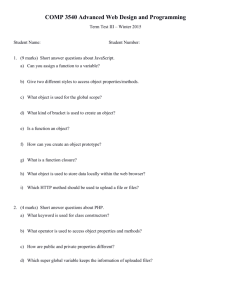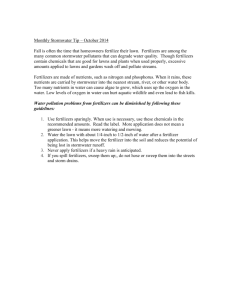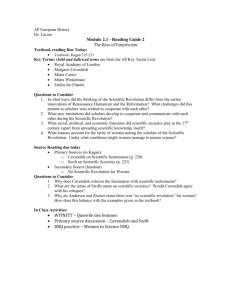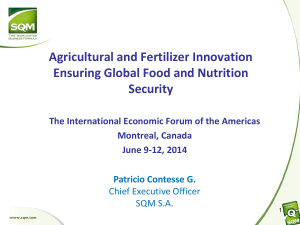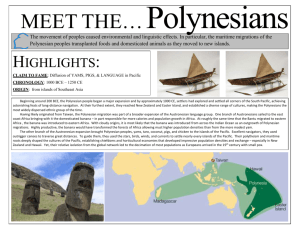Full-Text
advertisement
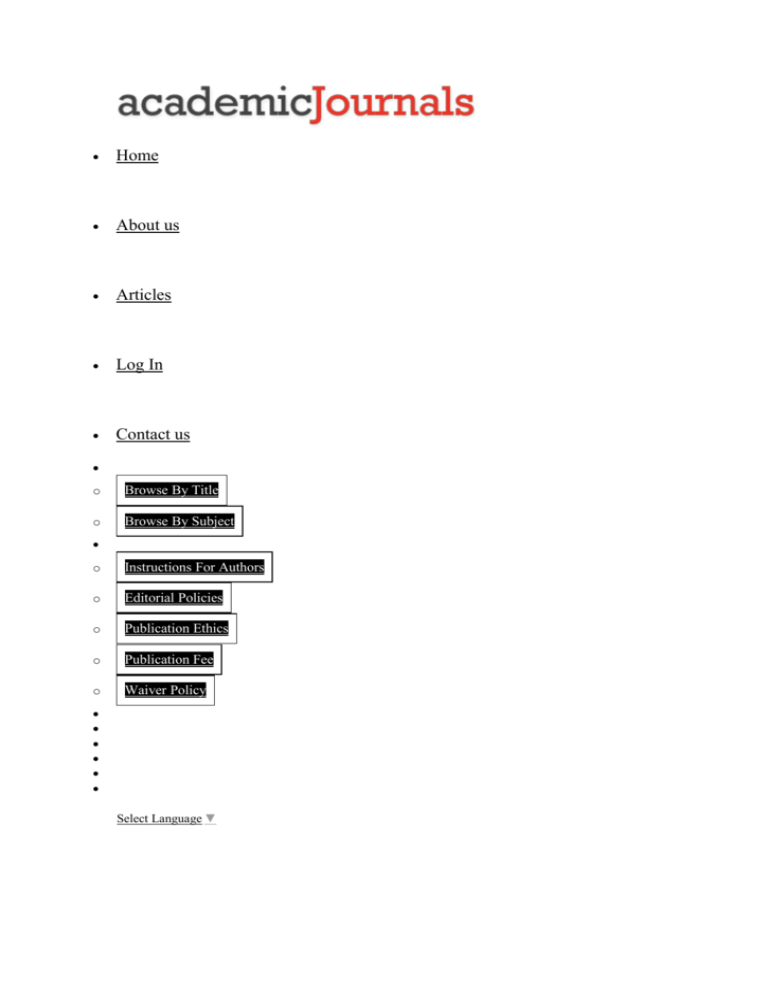
Home About us Articles Log In Contact us Journals o Browse By Title o Browse By Subject Authors o Instructions For Authors o Editorial Policies o Publication Ethics o Publication Fee o Waiver Policy Reviewers Editors Submit Manuscript Join Editorial Board F.A.Q Search Select Language ▼ JHF Home About JHF Abstracting & Indexing Editors Instructions for Authors JHF Articles Archive Quick Links Submit Manuscript Track your Manuscript Subscribe to RSS Subscribe to TOC Alert Article Menu • J. Hortic. For. • Vol. 7 No. 4 Abstract Authors Full-Text (HTML) Full-Text (PDF) Download XML Download E-book (PDF) References How to Cite this Article Article Metrics Cited by Articles: CrossRef Google Scholar Related Articles: On Google On Google Scholar Other Articles by Authors: Intisar Bakheit Elsadig H. Elsadig Article Number - 07C4D5851569 Vol.7(4), pp. 94-98 , April 2015 DOI: 10.5897/JHF2014.0384 ISSN: 2006-9782 Total Views: 285 Downloaded: 16 Full Length Research Paper Effects of organic and chemical fertilizers on yield and total soluble solids (TSS) in Banana Cavendish group (AAA) Intisar Bakheit Elsadig H. Elsadig Received: 17 December 2014 Accepted: 11 March 2015 Published: 01 April 2015 Copyright © 2015 Author(s) retain the copyright of this article. This article is published under the terms of the Creative Commons Attribution License 4.0 ABSTRACT Banana fruit production in the Sudan covers a wide spectrum of activities ranging from local utilization of fruit with selfsufficiency through small farming for local market to large plantation for export. It is one of the most important fruits of Sudan. Therefore, a field experiment was conducted at two locations during 2009\2010 and 2010\2011 in split-split plot layout with four replications. The main plots were the two varieties of Cavendish Dwarf and Grand Nain (AAA) and the sub-plots are the fertilizer treatments arranged randomly. The treatments consisted of urea (400 g/mat/yearr), NPK (200 g/mat/year) and in combination with organic fertilizers ,compost 10 kg/plant/year, manure 5 kg/plant/year). The results indicated that there were significant effects (p≤0.05) in fruit parameters (weight of bunch, hand, fingers and number of hands\bunch and fingers\bunch). The fertilizer treatment urea (400 g\mat\year), and urea plus organic manure in the two seasons were highly significant different. The results showed that there were highly significant increase in growth resulted from all fertilizer treatments and reflected in earlier shooting, 198 days in the main crop, 142 days in the first ratoon, and shorter time to flowering and harvest, 35 days in the main crop and 32 days in the first ratoon crop in Dwarf Cavendish compared to Grand Nain cultivars in the two seasons. Key words: Banana, varieties, fertilizers. INTRODUCTION Banana is one of the oldest tropical fruits cultivated by man from pre-historic times (INRI, 2001). Banana (Musa spp) member of the Musaceae family is one of the most important tropical fruit crops in the world and is a major tropical food crop with annual world production of around 88 million tons (Sharrock et al.,, 2001). Dwarf Cavendish is the predominant cultivar grown in Sudan especially in the Blue Nile and Kassala States (Elhassan et al., 2006; Elbashir and Imam, 2010). The experiment was done with two cultivars of Cavendish group, dwarf and giant Cavendish. Dwarf is the smallest or short and better adapted to a cool climate than any other cultivar. “Giant Cavendish” compared to dwarf is slightly taller and its French name is “Grand Nain”, Samson (1980). 'Grand Nain is an outstanding banana variety growing from 180 to 240 cm (6 to 8 feet) tall and with solid green color. It is very attractive as landscaping potential. The 'Grand Nain cultivar produces very large heads of delicious fruits. Bunches may weigh up to 60 kg (150 Lbs.). This is a commercial variety that you may buy in the grocery store. The word ‘‘banana” is a general term embracing a number of species or hybrids in the genus Musa of the family Musaceae. Most edible banana fruits are seedless. It belongs to the Species (Musa acuminate). Banana can be divided into two main groups, one is the dessert bananas which constitute 43% of world production (Jones, 2000), the fruits of this group are chiefly eaten raw when ripe as a dessert fruit, and the other group is the wild one filled with a great number of very hard seeds with thickness of 3 to 5 mm .Banana fruit production in the Sudan covers a wide spectrum of activities ranging from local utilization of fruit, through small farming for local market, to large plantation for export. The organic manure which was made from compost provides the nutrients necessary for the crop as nitrogen, phosphorus, potassium etc., and improves the chemical and physical characteristics of the soil. The soil fertility increases and it becomes soft and porous. Thus humidity is also maintained. In the Sudan commercial banana production is for local market. The cultivation is concentrated to the alluvial Delta of Gash River in Kassala State. In Kassala State there was a reduction in acreage. This reduction was mainly attributed to scarcity of irrigation water and to poor husbandry practices (ACCORD, 2010). There are many problems that hinder the production of banana such as nematode infestation, scarcity of suckers and the depen-dence on one variety, in addition to the lack of knowledge about the cultural practices, and absence of detailed agricultural operations, such as fertilization planting methods, variety, spacing, and pruning ,ripening and marketing programs of the future. Therefore, to stimulate banana crop production and make it commercially fea-sible, considerable research should be geared towards investigating ,recognizing and solving the problems facing banana industry in the country. Fertilization is an important and limiting factor for growth and productivity of banana. The plants remove large amounts of nutrients from the soil as it is well known that banana needs large amounts of fertilizers especially nitrogen. Therefore the major problems facing banana growers are the high costs of manufactured fertilizers needed for banana production (El Moniem et al., 2008; ACCORD, 2010). Besides, these chemical fertilizers are considered as air, soil and water polluting agents during their production and utilization. Consequently, it has drawn the attention of researchers and banana growers to use the organic fertilizers, which are safe for human, animal and environment, as a partial substitute for mineral source. Thus, it is preferred to use these natural fertilizers to avoid pollution and to reduce the costs of chemical fertilizers. In the experiments two types of fertilizers were used, organic manure (cow and chicken) and chemical fertilizer (Urea+ NPK) and the combinations of the two fertilizers. The objective of this study is to investigate the effect of organic manure and chemical fertilizers on growth and yield of two banana cultivars namely Dwarf Cavendish and Grand Nain, and to determine the dose of fertilizers which influence the yield and fruit characte-ristics, like total bunch weight ,middle hand weight and number of fingers per middle-hand. MATERIALS AND METHODS The present study was carried out in Alliab area in the River Nile State in Sudan, during the period from June to September (2009\2010 and 2010/2011). The climate of the area is desert, hot summer, warm winter and with summer rain (Van der Kevie, 1976). The soil samples were analyzed for physical and chemical characters according to the standard procedure (Table 1) .The design was split plot design. The experiment was carried out as split-split plot based on randomized complete block design (RCBD) with four replications and 18 treatments; the main plots are the two varieties of Dwarf Cavendish (AAA) and Grand Nain (AAA) and the subplots are the fertilizer treatments arranged randomly. Planting materials are suckers of the banana cultivars, Dwarf Cavendish and Grand Nain, four months old, sword type. The suckers were obtained from a plantation in Shendi locality. The experiment in sub plots consisted of, urea 400 g/mat/year, NPK (18:18:18) : 18 g/mat/year, and the organic fertilizers, compost 10 kg/plant and manure 5 g/mat/year). The bunches were weighed using spring balance. To determinate the weight of fingers, the weight of all hands in a bunch was divided by the total number of fingers in that bunch. RESULTS AND DISCUSSION Generally the results in the two seasons indicated that there were significant differences (p≤0.05) in weight of bunch, number of hands/bunch, number of fingers/ bunch, and weight of hands/bunch and earlier times to flowering and to harvesting in all fertilizers treatments, especially the treatments manure (M), Compost + Urea (C+U) and Urea (U) as compared to the control (Table 2). In addition to that, the cultivar Grand Nain was more res-ponsive than Dwarf Cavendish in all parameters (Figure 1); this result indicates that cultivars respond differently to fertilizer treatments and this is may be due to the genetic differences between the two cultivars. These findings are in agreement with that of Gangwar and Niranjan (1990) who studied the effect of inorganic fertilizers and FYM on the rain-fed fodder sorghum. They found that addition of FYM+50% recommended doses of inorganic fertilizer resulted in significantly higher plant height, dry weight, and fresh weight and increased the uptake of N, P and K compared with the control. This is also in agreement with Singh and Suryanaryana (1999) and Manica et al. (1978) who recorded the highest bunch weight and fruit yield by 200 g N .Dawoud et al. (1991) studied the response of dwarf Cavendish banana to nitrogen fertilization on heavy clay soils. The heavy clay soils of Sudan are low in N and organic matter. The effect of N (0276 g/mat/year on the growth and yield of bananas Cv. Dwarf Cavendish (plant crop and first ratoon) was investigated over 6 years (1988-1994), and the results indicated that the application of 138 g N\mat was the best rate for growth and yield .Bulter (1960) reported that substantial increase in mean weight of bunch and total production per hectare were mainly obtained by application of nitrogen-containing compounds especially when those applied in small quantities. Fruit green life is a very important parameter in the banana industry. Hence, fruit green life and TSS content are used as criteria for screening and selection of promising banana clones for commercial production (Dadzie and Orchard, 1997). Application of fertilizers combinations influenced the reproductive characteristics of Grand Nain .The results as indicated in Tables 2 and 3 showed that there were highly significant increase in growth resulted from all fertilizer treatments reflected in earlier shooting and shorter time to flowering and harvest in Dwarf Cavendish compared to Grand Nain clones in the two seasons, the time to harvest was 198 days in dwarf and 142 days in Grand Nain. Robinson (1995) stated that the duration from flowering to harvesting of Cavendish subgroup range between 110 and 240 days in subtropical areas .Also the data depicted in Table 2, compost and manure plus urea, and urea alone, resulted in earlier shooting and less time from shooting to harvesting. This result is in agreement with Arunachalam et al. (1976) who reported that excessive nitrogen levels increased the length of maturation period while adequate nitrogen levels caused earlier inflorescence and shortened the time from planting to shooting by 16 days and decreased maturation period by 14 days and thus the whole cycle by one month. The results presented in Table 4 showed that total soluble solids (TSS) in green mature fruit were significantly higher in plants treated with fertilizer, and highly significant in the two cultivars in the two seasons, so the effect of the treatment of compost+Urea on TSS in green fruit and TSS in mature fruit in Grand Nain cultivar is more than in Dwarf Cavendish, this was in agreement with Dadzie and Orchard (1997) who compared the total soluble solids of the cultivars Grand Nain and Williams with those of the genotypes FHIA-01 and FHIA-02. They found that the mean total soluble solids content of Grand Nain and Williams were comparable but significantly higher than those of FHIA-01 and FHIA-02 (Dadzie and Orchard, 1997). Since the amount of total soluble solids (TSS) in fruits usually increases as they ripen, they can be a useful index of stage of ripeness .Dadzie and Orchard (1997) reported that sugars form the main component of total soluble solids in ripe fruit, which resulted from starch degradation. CONCLUSION Application of four levels of NPK (18:18:18) 200 5 g/mat/year, urea 400 5 g/mat/year, and organic fertilizer (compost chicken manure) for the two cultivars of Cavendish group, greatly influenced yield characteristics including total bunch weight, total fruit weight, hand weight and number of fingers and fruits per hand. However, fertilizers had significant effects on TSS of the fruit. The highest values of yield components were significantly greater in both, plant crop and first ratoon crop, in weight of bunch, hand and fingers and in the average number of hands and fingers per bunch and fingers per hand. In addition to that there was significant difference in length of finger in both crops. The organic fertilizer with urea and NPK was the best. There were shorter days from planting to shooting and from shooting to harvesting for the two seasons. Combination of fertilizers gave the highest values than the single fertilizer and the control. CONFLICT OF INTEREST The authors have not declared any conflict of interest. REFERENCES ACCORD, Agency for Co-operation and Research in Development (2010). Problems facing Small Scale Farmers in Kassala State:Focus on Bananas. From food security to food sovereignty. Citizens and local authorities towards a new paradigm in Europe to reduce world hunger. View Arunachalam A, Maithani K, Pandey HN, Tripathi RS (1996). The impact of disturbance on detrital dynamics and soil microbial biomass of a Pinus kesiya forest in North-east India. For. Ecol. Manage. 88:273–282.9 Crossref Bulter AF (1960). Fertilizer experiments with the Gros Michel banana. Trop. Agric. Trin. 37:31-50 Dadzie BK, Orchard JE (1997). Routine postharvest screening of banana/plantain hybrids: Criteria and method, technical guidelines, International Ne-work for Improvement of Banana and Plantain 2. Montpellier, France. Dawoud DH, Salih AA, Ali IA (1991). Response of Dwarf Cavendish banana to nitrogen fertilization on heavy clay soils. Sudan J. Agric. Res. 2:89-91. Elbashir HA, Mohamed AI (2010). Status Report on Fruits and Vegetables Production and Processing Industry in Sudan. AARDO Workshop on Technology on Reducing Post-harvest Losses and Maintaining Quality of Fruits and Vegetables. pp. 168-17. View Elhassan AAM, Abu-Sara AF, Elsir A, Eldin SMS (2006). Response of Dwarf Cavendish Banana to Potassium Sulfate in Sennar Area." Proceedings the 39th and 40th meetings of the National Crop Husbandry Committee, Wad Medani (Sudan). ARC El Moniem EAA, Abd-Allah ASE, Ahmed MA (2008). The combined effect of some organic manures, mineral N fertilizers and algal cells extract on yield and fruit quality of Williams banana plants. Am-Euras. J. Agric. Environ. Sci. 4:417-426. Gangwar AC, Niranjan WH (1990). The economics of Adverse Ground Water Conditions, Haryana State. Indian J. Agric. Econ. 42(2):160-172. Jones DR (2000). Introduction to banana, abaca and enset. In: Jones DR (ed.), Diseases of Banana, Abaca and Enset. CAB International, Wallingford, UK. Manica IBV, Defelipo AR, Condie JL, Passas IC (1978). The response of banana cultivar Nanico to fertilization. Phosphorus potassium. Rev. Gres. 25: 549-553. Robinson JC (1995). Systems of cultivation and management in bananas and plantains. INIBAP, Chapman and Hall Publications. pp. 237. Samson JA (1986). Tropical Fruits. Second edition. Pp. 140-157. Sharrock SL, Horry JP, Frison EA (2001). The state of the use of Musa diversity. In: Cooper HD, Spillane C, Hodgkin T (eds.), Broadening the Genetic Base of Crop Production. IPGRI/FAO. P 223 Crossref Singh DB, Suryanaryana MA (1999). Response of "Cavendish" banana to different nitrogen levels and their split applications. J. Appl. Hort. 1(2):122-124. Van der Kevie W (1976). Manual for land suitability classification for agriculture. Part II, Guide-lines for soil survey party chiefs. Soil Survey Administration, Sudan. Abstract Full-Text HTML Full-Text PDF Download E-book Home About us Memberships & Standards Open Access Open Archives Initiatives Contact us Journals View Articles Submit Manuscript Track your Manuscript Manuscript Handling Fees Waiver Policy Editorial Policies Publication Ethics Reviewers Guidelines Join Editorial Board Subscribe to Alerts Subscribe to RSS © 2002-2015 | Terms Of Use Scroll ABSTRACT INTRODUCTION MATERIALS AND METHODS RESULTS AND DISCUSSION CONCLUSION CONFLICT OF INTEREST REFERENCES
